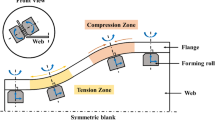Abstract
Bent pipes are key components employed in vast quantities and diversities for satisfying the increasing demand for lightweight and high-strength products. Consequently, pipe bending has become an attractive manufacturing technology for lightweight product forming. This study examined the roll-bending process using a computer numerically controlled (CNC) profile bending machine equipped with three driving rolls. In this process, process design variables should be precisely designed to obtain smoothly curved pipes with high precision and without defects. Specifically, the central roller position must be precisely determined by considering springback?which is inevitable in the cold-forming process. A numerical approach was applied to calculate the central roller position for producing the required curvature. The established FE model was compared with experimental results for validation and then used to obtain the relationship between the central roller stroke and the final curvature of the bent pipe for various pipe material properties and cross-sections. The central roller position for producing the desired curvature was determined using a pipe deformation database obtained from a series of forming simulations, and the usefulness of the proposed numerical approach was evaluated.
Similar content being viewed by others
References
Soda, C. and Konishi, S., “A Study of the Deformation of Beams by a Three-Roll Bending Process,” Journal of the Japan Society for Technology of Plasticity, Vol. 112, pp. 474–484, 1962.
Hansen, N. E. and Jannerup, O., “Modelling of Elastic-Plastic Bending of Beams using a Roller Bending Machine,” Journal of Manufacturing Science and Engineering, Vol. 101, No. 3, pp. 304–310, 1979.
Yang, M., Shima, S., and Watanabe, T., “Model-based Control for Three-Roll Bending Process of Channel Bar,” Journal of Manufacturing Science and Engineering, Vol. 112, No. 4, pp. 346–351, 1990.
Trostmann, E., Hansen, N., and Cook, G., “General Scheme for Automatic Control of Continuous Bending of Beams,” Journal of Dynamic Systems, Measurement, and Control, Vol. 104, No. 2, pp. 173–179, 1982.
Hardt, D. E., Constantine, E., and Wright, A., “A Model of the Sequential Bending Process for Manufacturing Simulation,” Journal of Manufacturing Science and Engineering, Vol. 114, No. 2, pp. 181–187, 1992.
Yang, M. and Shima, S., “Simulation of Pyramid Type Three-Roll Bending Process,” International Journal of Mechanical Sciences, Vol. 30, No. 12, pp. 877–886, 1988.
Yang, M., Shima, S., and Watanabe, T., “Model-based Control for Three-Roll Bending Process of Channel Bar,” Journal of Manufacturing Science and Engineering, Vol. 112, No. 4, pp. 346–351, 1990.
Hardt, D. E., Roberts, M. A., and Stelson, K. A., “Closed-Loop Shape Control of a Roll-Bending Process,” Journal of Dynamic Systems, Measurement, and Control, Vol. 104, No. 4, pp. 317–322, 1982.
Yang, G., Mori, K. I., and Osakada, K., “Determination of Forming Path in Three-Roll Bending using FEM Simulation and Fuzzy Reasoning,” Journal of Materials Processing Technology, Vol. 45, No. 1, pp. 161–166, 1994.
Hua, M., Sansome, D. H., and Baines, K., “Mathematical Modeling of the Internal Bending Moment at the Top Roll Contact in Multi-Pass Four-Roll Thin-Plate Bending,” Journal of Materials Processing Technology, Vol. 52, No. 2, pp. 425–459, 1995.
Hua, M., Baines, K., and Cole, I. M., “Continuous Four-Roll Plate Bending: A Production Process for the Manufacture of Single Seamed Tubes of Large and Medium Diameters,” International Journal of Machine Tools and Manufacture, Vol. 39, No. 6, pp. 905–935, 1999.
Shin, J. G., Park, J. T., and Yim, H., “Kinematics-based Determination of the Rolling Region in Roll Bending for Smoothly Curved Plates,” Journal of Manufacturing Science and Engineering, Vol. 123, No. 2, pp. 284–290, 2001.
Gandhi, A. H. and Raval, H. K., “Stress Strain Curve for Multiplepass Loading of Ductile Material,” Proc. of the International Conference on Recent Advances in Mechanical& Materials Engineering, pp. 175–180, 2005.
Gandhi, A. H. and Raval, H. K., “Analytical Modeling of Top Roller Position for Multiple Pass (3-Roller) Cylindrical Forming of Plates,” Proc. of ASME International Mechanical Engineering Congress and Exposition, pp. 107–116, 2006.
Kajrup, G. and Flamholz, A., “Bending the Wind-Roll Bending Challenges in Fabricating Conical Cylinder Wind Towers,” The Fabricator, 2003.
Seddeik, M. M. and Kennedy, J. B., “Deformations in Hollow Structural Section (HSS) Members Subjected to Cold-Bending,” International Journal of Mechanical Sciences, Vol. 29, No. 3, pp. 195–212, 1987.
Chen, S. J. and Chang, S. C., “Residual Stresses in Welded Jumbo Box Columns,” Journal of Constructional Steel Research, Vol. 25, No. 3, pp. 201–209, 1993.
Rasmussen, K. J. R. and Hancock, G. J., “Deformations and Residual Stresses Induced in Channel Section Columns by Presetting and Welding,” Journal of Constructional Steel Research, Vol. 11, No. 3, pp. 175–204, 1988.
Landolfo, R. and Mazzolani, F. M., “The Influence of the Variation through the Thickness of Residual Stresses in Tubular Columns,” Journal of Constructional Steel Research, Vol. 19, No. 1, pp. 49–57, 1991.
Tehrani, M. S., Hartley, P., Naeini, H. M., and Khademizadeh, H., “Localised Edge Buckling in Cold Roll-Forming of Symmetric Channel Section,” Thin-Walled Structures, Vol. 44, No. 2, pp. 184–196, 2006.
Li, S. H., Zeng, G., Ma, Y. F., Guo, Y. J., and Lai, X. M., “Residual Stresses in Roll-Formed Square Hollow Sections,” Thin-Walled Structures, Vol. 47, No. 5, pp. 505–513, 2009.
Arnet, H. and Geiger, M., “Controlled Section Bending by using a Neural Network,” Proc. of the 29th CIRP International Seminar on Manufacturing Systems, pp. 108–113, 1997.
Paulsen, F. and Welo, T., “Application of Numerical Simulation in the Bending of Aluminium-Alloy Profiles,” Journal of Materials Processing Technology, Vol. 58, No. 2, pp. 274–285, 1996.
Welo, T., Paulsen, F., and Brobak, T., “The Behaviour of Thin-Walled, Aluminium Alloy Profiles in Rotary Draw Bending-A Comparison between Numerical and Experimental Results,” Journal of Materials Processing Technology, Vol. 45, No. 1, pp. 173–180, 1994.
Lange K., “Handbook of Metal Forming,” McGraw-Hill, USA, pp. 325–327, 1985.
Author information
Authors and Affiliations
Corresponding author
Rights and permissions
About this article
Cite this article
Baek, GY., Shim, DS. FE Simulation-based process design for manufacturing structural members of commercial vehicle using pipes with rectangular Cross-Sections. Int. J. Precis. Eng. Manuf. 16, 723–733 (2015). https://doi.org/10.1007/s12541-015-0096-z
Received:
Revised:
Accepted:
Published:
Issue Date:
DOI: https://doi.org/10.1007/s12541-015-0096-z




